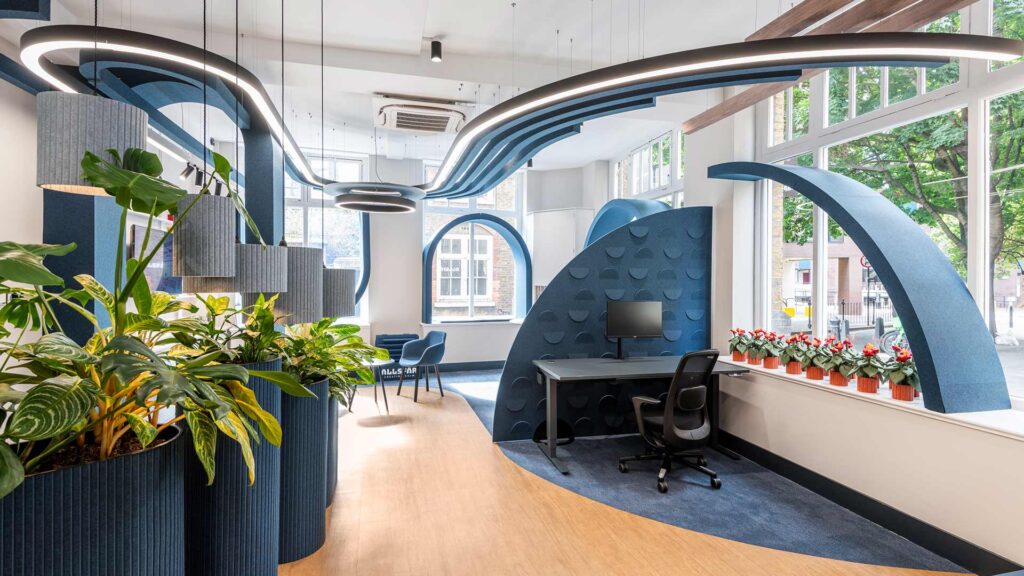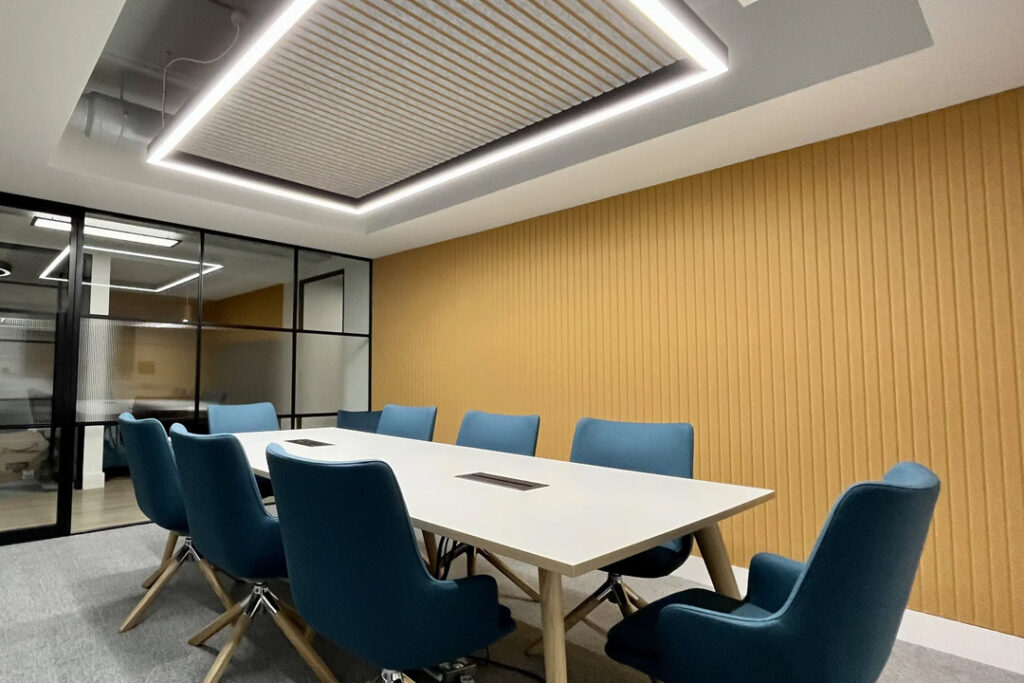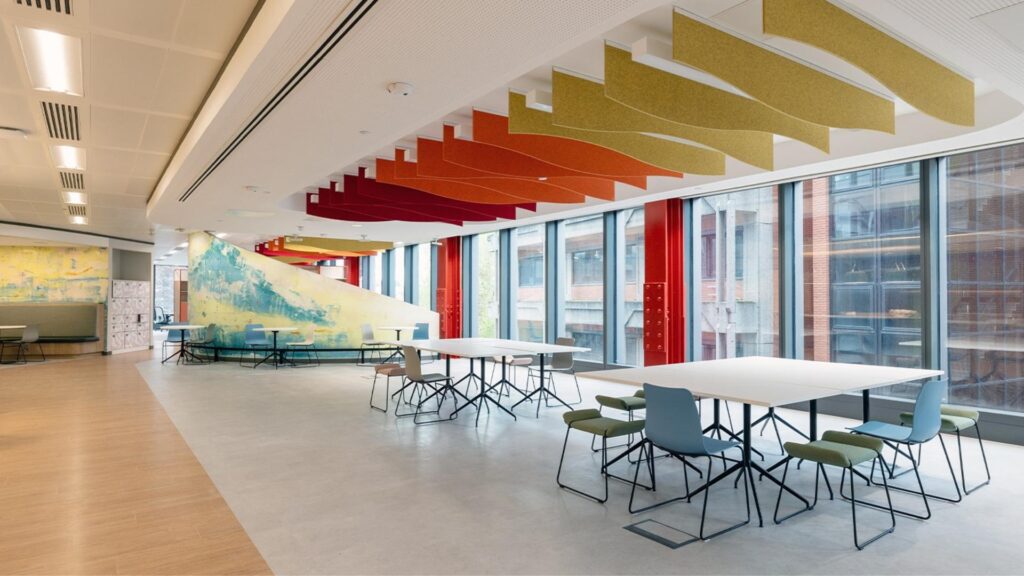
Beyond Function: How Light & Acoustics Shape How We Feel at Work
On Thursday, 6th November, we were thrilled to welcome guests to our London showroom for an evening event and panel discussion exploring how light and acoustics do far more than serve a practical purpose; they shape how we feel at work.
Our brilliant panel featured Debbie Watts from Ashlar ID, Miles Cantley, Innovation Director at Mount Lighting, Morgan Doouss, Founder of AllSfär, and Fraser Smith, Specification Manager at AllSfär. Together, they shared insights on how sensory-led design can transform the workplace experience from improving wellbeing and focus to creating environments that inspire calm and creativity.
The panel opened with a simple but powerful idea: data alone can’t create inspiring spaces; design needs emotion too.

Lighting That Feels Human
Lighting is often reduced to figures, lux levels, lumens, and UGR values, but the panel made it clear that good lighting is as much about emotion as it is about performance.
Human-centred lighting design starts by thinking about how people use spaces throughout the day. Cooler, white light (around 4000K) supports focus and alertness, while warmer tones (around 3000K) promote calm and relaxation. Mixing the two thoughtfully can subtly influence how people feel and behave.
Yet, lighting design is often dominated by data and standards like CIBSE LG7, which risk producing soulless, one-size-fits-all solutions. The real goal is to create light that feels natural.
That’s where dynamic lighting comes in, mimicking the natural progression of daylight to support the body’s circadian rhythm. It’s a challenge to replicate natural light, as sunlight is not just visible light, but UV and IR. Still, even small steps towards this can have a big impact.
The right lighting is so important, especially considering:
- The WELL standard links good lighting to improved sleep, mood, and focus.
- Circadian lighting can help regulate the body’s internal clock, supporting healthier sleep patterns and cognitive performance.
- Studies show that workers in well-lit environments report higher job satisfaction and up to 15% greater productivity.
Lighting should be intuitive, flexible, and emotionally engaging, something people experience, not just see. To sum it up, “Think in scenes, not fittings.”

Acoustic Comfort and Wellbeing
Noise is one of the most overlooked yet impactful elements of workplace design. The discussion around acoustics made it clear that comfort isn’t about silence, it’s about balance.
According to research:
- Office employees lose up to 86 minutes of productive work every day due to noise disruptions (Ipsos & Steelcase).
- 81% of UK professionals say office noise affects their performance, up sharply from 41% in 2022.
- It takes around 23 minutes to regain focus after a distraction (University of California, Irvine).
Beyond productivity, noise directly affects wellbeing. Half of UK office workers report feeling stressed by workplace noise, while high reverberation times increase stress and reduce clarity.
For neurodivergent people, including those with ADHD, autism, or dyslexia, sound sensitivity can make the workplace overwhelming. Inclusive design means creating spaces where everyone can focus, communicate, and thrive.
Key to this is understanding reverberation time (RT60), the time it takes sound to fade after a noise stops. Recommended ranges include:
- 0.5 seconds for open offices
- 0.4–0.6 seconds for classrooms and libraries
- 0.7–0.8 seconds for hospitality areas
Balancing reflection and absorption through materials like wall panels, ceiling rafts, and acoustic artwork creates spaces that sound as good as they look.

Designing for the Senses
Finally, the discussion turned to the senses we often overlook in design, particularly smell.
Our sense of smell is deeply tied to memory and emotion. In fact, around 3% of our genes are dedicated to scent detection, and Scent signals travel directly to the brain’s limbic system, the part responsible for emotion and memory.
Subtle natural fragrances can enhance calm, focus, and wellbeing, adding a deeper layer of sensory connection to a space. When used thoughtfully, scent becomes another way to create environments that feel grounded, human, and memorable.

The evening wrapped up with a shared understanding that truly great workspaces go far beyond meeting technical standards; they’re designed to make people feel something. When all the senses are considered together, they create a harmony that supports focus and reduces stress. It’s not just about function or aesthetics, but about how design influences emotion, behaviour, and wellbeing day to day.
If you want to find out more about acoustic solutions that could help you achieve a workspace that is comfortable for everyone book a lunch and learn with us, by emailing hello@allsfar.com
Want to explore acoustic solutions that are tailored to your next design project? Take a look at our full range of acoustic solutions here or give us a call on +44 (0)20 3889 9888, email us at hello@allsfar.com or fill in our contact form on our website here.
Keep In Touch
Sign up to our newsletter and find out about our latest products, new projects and showroom events.
Products
AllSfär © 2025